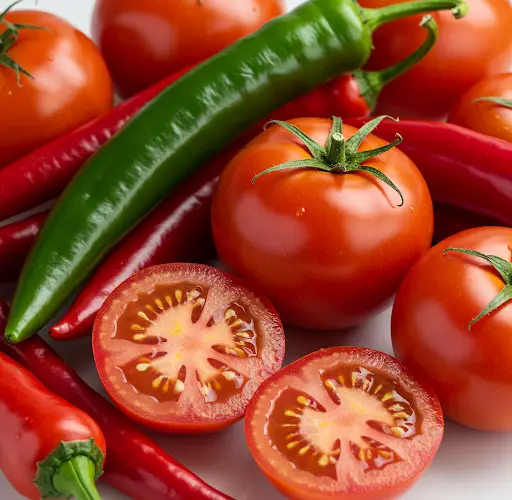The Essential Soil Boost for Growing Strong Peppers and Tomatoes
When it comes to growing strong and healthy peppers and tomatoes, soil preparation is crucial. Experts always recommend adding specific nutrients and organic matter to the soil before planting, as this ensures the plants grow robustly and produce an abundant harvest. Without proper soil enrichment, seedlings, especially delicate ones like tomatoes and peppers, may struggle to establish their roots, making them more susceptible to diseases like black leg. However, with a few simple additions to the soil, you can give your seedlings the necessary boost to thrive.
Step 1: Prepare the Planting Hole
The first step to ensuring strong, healthy plants is to prepare the soil properly. When planting your tomatoes or peppers, dig a hole that matches the size of the root ball of your plant. This ensures that the roots have enough space to spread out and establish themselves. If the roots are cramped, the plant won’t grow as well and may become weak or vulnerable to diseases.
Step 2: Add Organic Matter for Fertility
Once the hole is ready, it’s time to add some nutrients to improve the soil structure. Start by adding a handful of compost or manure into the hole. Compost is rich in organic matter and beneficial microorganisms, which provide plants with essential nutrients like nitrogen, phosphorus, and potassium. These nutrients help the plants grow strong, develop healthy roots, and resist diseases.
If you don’t have compost on hand, fully decomposed manure is an excellent alternative. It works similarly to compost, adding nutrients to the soil and enriching it with organic matter. This ensures that the soil has the right balance of nutrients needed to support the plants’ growth.
Step 3: Enhance Soil Health with Rice Flour and Turmeric
In addition to compost or manure, adding rice flour and turmeric to the planting hole can provide even more benefits to your plants. Rice flour is a valuable source of nitrogen, phosphorus, potassium, and other trace elements, which are essential for healthy plant growth. These nutrients contribute to stronger plants and better fruit production.
Turmeric, well-known for its culinary uses, also offers impressive benefits in the garden. It has natural antibacterial and antiviral properties that help maintain soil health and prevent diseases. By incorporating turmeric into the soil, you can reduce the likelihood of common soilborne diseases that affect tomatoes and peppers, such as root rot and blight.
Mix 1 tablespoon of rice flour and half a teaspoon of turmeric into the soil, along with the compost or manure. This combination creates a nutrient-rich environment that will encourage strong, healthy growth for your seedlings.
Step 4: Planting for Strong Roots
When it comes time to plant your seedlings, there’s a helpful trick to ensure they develop strong root systems. For tomatoes, it’s beneficial to remove the lower leaves of the seedling and plant the stem deep into the soil. By burying part of the stem, you encourage the plant to develop additional roots along the buried section, which gives the plant more stability and access to nutrients.
This technique not only encourages better root development but also helps the plant become sturdier and more resilient. The more roots the plant has, the better it can absorb water and nutrients from the soil, which leads to faster growth and larger yields.
Step 5: Ongoing Feeding for Established Seedlings
Even after planting, it’s important to continue feeding your seedlings regularly to ensure they remain healthy and productive. If your seedlings are already in the ground, they still need nourishment to help them grow strong and develop thick stems and lush foliage.
You can easily make a liquid fertilizer at home using rice flour, turmeric, and compost or manure. To prepare this homemade fertilizer, dissolve a handful of compost or manure, 1 tablespoon of rice flour, and half a teaspoon of turmeric into 1 liter of hot water (around 70 to 80°F). Let the mixture sit for several hours to allow the nutrients to infuse before using it to fertilize your plants.
This liquid fertilizer can be applied every two weeks to provide your plants with a steady supply of nutrients throughout the growing season. The nutrients from the rice flour, turmeric, and compost will help maintain healthy root growth, protect against diseases, and promote strong plant development.
Step 6: Promoting Disease Resistance and Abundant Harvests
By following these steps—preparing the planting hole with compost, rice flour, and turmeric, planting deeply for strong root systems, and feeding your plants regularly with homemade liquid fertilizer—you’ll help your seedlings grow strong and healthy. The combination of proper soil preparation and ongoing nourishment will not only protect your plants from diseases but also promote vigorous growth and higher yields.
Whether you’re growing tomatoes, peppers, cucumbers, or other plants, proper soil preparation and regular feeding are essential for supporting their growth and ensuring a bountiful harvest. Strong plants, with healthy root systems and thick stems, are better able to withstand environmental stresses like drought and pests, ensuring they thrive throughout the growing season.



